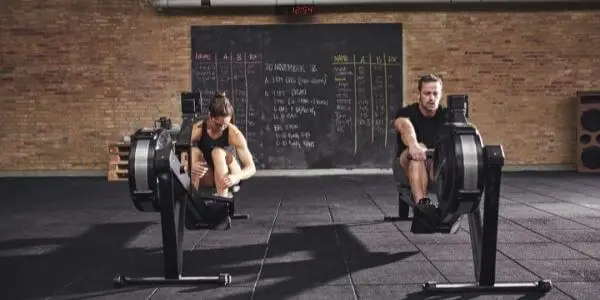It is important to know the difference between an air rowing machine and a magnetic rower. The former creates resistance by blowing air against the flywheel, while the latter utilizes magnets to create resistance.
Air rowers are generally cheaper than magnetic rowers – they also offer an authentic experience as you can feel when your muscles contract and relax.
Most people have no idea that there are different types of rowers. They just hop on the machine and start rowing – isn’t that the point?
But indeed, there are a lot of choices when it comes to buying or trying a rowing machine in a gym. And getting the right resistance for you is essential to your success.
So, what’s the difference between air and magnetic rowing machines? And which one is right for you? In this post, we’ll break it down for you.
Spoiler alert: air rowers are generally noisy, while magnetic rowers are virtually silent.
Read on to find out more!
Air vs Magnetic Rower – which one is better?
We’ll first start with a brief overview of each type of resistance, analyzing its benefits and disadvantages.
The benefits and disadvantages of air rowers

Air rowing machines are generally cheaper than their magnetic counterparts. Air rowers also offer a more natural rowing experience since they mimic the resistance of rowing on water.
An air rower uses wind resistance to create a challenge for the user. The fan blades spin when you pull the handle, and the faster they spin, the more resistance is created. This can be a plus for people who want to feel like they’re getting a more authentic workout. After all, most professional athletes use air rowers for their training.
The downside of air rowers is that they require more effort to use. This is because the fan creates resistance by blowing air against the flywheel. The faster you rower, the more resistance you feel. So, if you’re a beginner looking for an easy workout, an air rower is probably not the best choice. Additionally, air rowers can be loud, so if you’re looking for a machine that won’t disturb your family or roommates, a magnetic rower might be a better option.
The benefits and disadvantages of magnetic rowers

A magnetic rower uses – you guessed it – magnets to create resistance. Magnetic rowers offer more resistance levels than air rowers, making them a good choice for people who are looking for a challenging, customized workout.
Wouldn’t it be easier if all you had to do was set the rowing machine’s resistance to a certain level and then row away? That’s exactly how magnetic rowers work. By using magnets, these rowing machines create a smooth and consistent resistance, which can be beneficial if you’re new to rowing or have joint problems.
Additionally, magnetic rowers are typically a lot quieter than air rowers, so they are more suitable for apartments or small places.
The downside of magnetic rowers is that they are generally more expensive than air rowers. But some people might find that the rowing motion on a magnetic rower is less natural than on an air rower.
Monitors
The monitor is an important aspect of any rowing machine. After all, how else are you going to track your progress? Air rowers typically have simpler monitors than magnetic rowers. This is because they don’t need as much electronic equipment to function.
Magnetic rowers, on the other hand, tend to have more complex monitors since they offer more resistance levels. This means that you can track your progress more easily and see how your workouts are improving over time.
Monitors typically track distance, time, number of strokes, and heart rate.
Included Programs

Most rowing machines come with pre-programmed workouts to help you get started. These programs are typically simple and easy to follow.
Air rowers usually have fewer programs than magnetic rowers. However, some air rowers come with heart rate monitors and other features that can help you customize your workout.
Magnetic rowers generally have more programs than air rowers – of course, the amount you pay for one highly influences its monitor functions. But typically you find more advanced workouts on a magnetic rower due to the fact that you can easily modify the resistance. Same again, most magnetic rowers come with heart rate monitors and other features that can help you get a highly customized workout.
How to choose the right resistance for you
The great thing about rowing machines is that they offer a low-impact workout that can be customized to your fitness level. If you’re a beginner, you’ll want to start with a lower resistance so you can get used to the rowing motion. As you become more fit, you can increase the resistance to make your workout more challenging.
If you’re looking for a more challenging workout, a magnetic rower is probably the best choice since you can easily adjust the resistance. However, if you’re on a budget or you’re looking for a more authentic workout experience, an air rower is the go-to option.
In conclusion
Both air and magnetic rowers have their own benefits and disadvantages. Air rowers are generally cheaper and quieter, while magnetic rowers offer more resistance and programs. The best machine for you depends on your fitness level and your budget. If you’re looking for an authentic rowing experience, an air rower is a good option. But if you want a more challenging, highly customizable workout, a magnetic rower is probably the best choice.
Whichever you chose, you can’t go wrong – rowing machines are a great way to get a low-impact, full-body workout. So get out there and start rowing!
- 10 Monday Fitness Motivation Quotes That’ll Get You Pumped - October 11, 2022
- Rebounding for Weight Loss: How Does It Work and How Long Do You Need? - September 16, 2022
- The Muscles Worked by the Stairmaster – How to Maximize Results - September 16, 2022

